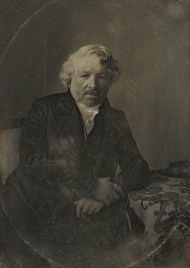Louis Jacques Mandé Daguerre In 1848
Louis-Jacques-Mandé Daguerre (French18 November 1787 – 10 July 1851) was a French scientist, artist and photographer, recognized for his invention of the eponymous daguerreotype process of photography.
He became known as one of the fathers of photography. Though he is most famous for his contributions to photography, he was also an accomplished painter, scenic designer, and a developer of the diorama theatre.
Louis Daguerre was born in Cormeilles-en-Paris, Val-d'Oise. He was apprenticed in architecture, theatre design, and panoramic painting to Pierre Prévost, the first French panorama painter. Exceedingly adept at his skill of theatrical illusion, he became a celebrated designer for the theatre, and later came to invent the diorama, which opened in Paris in July 1822.
In 1829, Daguerre partnered with Nicéphore Niépce, an inventor who had produced the world's first heliograph in 1822 and the oldest surviving camera photograph in 1826 or 1827.
Niépce died suddenly in 1833, but Daguerre continued experimenting, and evolved the process which would subsequently be known as the daguerreotype.
Arrangements were made for Daguerre's rights to be acquired by the French Government in exchange for lifetime pensions for himself and Niépce's son Isidore; then, on 19 August 1839, the French Government presented the invention as a gift from France "free to the world", and complete working instructions were published.
In 1839, he was elected to the National Academy of Design as an Honorary Academician.
Admin
487 Photos
-
85
-
0
-
0
License and Use
Free for commercial use Attribution required- Details
- Year Taken 1848
- Country France
- Photo #152
- Published on Jun 12, 2025
- Photo type PNG
- Resolution 1879x2654
- Photographer Louis Jacques Mandé Daguerre
- Category photographers
- File size 5.5MB



